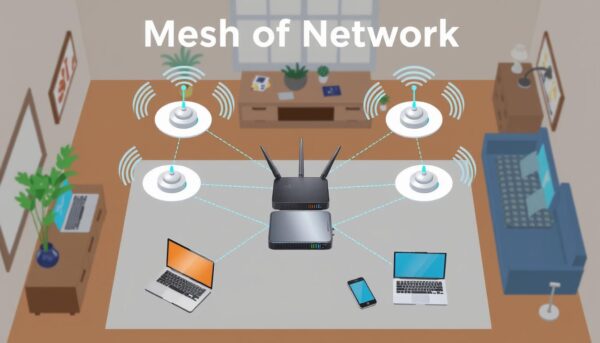✅ Last checked on
Are you tired of dealing with dead zones and weak Wi-Fi signals at home? A mesh network setup can solve these issues. It offers a strong and reliable internet connection everywhere in your home. But, you might wonder, what makes mesh networks so effective and how to set one up easily?
To learn more about different home network topologies, visit home network topologies. Discover the benefits of a mesh network setup.
Key Takeaways
- A mesh network setup provides a strong and reliable internet connection throughout your home.
- A mesh network installation is easy to set up and can be done in a few simple steps.
- Mesh networks are ideal for homes with multiple devices and a large coverage area.
- A mesh network setup can reduce dead zones and improve overall network performance.
- Regular updates and security checks are essential for maintaining optimal mesh network performance.
- A mesh network consists of multiple devices (nodes) that work together to provide a strong internet connection.
- Optimal node placement can improve WiFi signal range up to two-thirds of the maximum wireless range of each satellite node.
Understanding Mesh Network Basics
Setting up a Mesh Network starts with knowing how they work. Mesh networks let devices talk to each other directly, without a central router. This forms a web-like structure, where each device helps pass data to others.
The way you set up a Mesh Network affects its performance. A good setup means fast and reliable internet, even in hard-to-reach areas. Many people choose mesh networks for their ability to cover the whole home well.
Some key benefits of mesh networking are:
- Improved coverage and reduced dead zones
- Increased speed and reliability
- Easier network management and configuration

Learning about mesh networks and how to set them up can give you a fast, reliable internet. It’s easier than traditional networking methods.
| Mesh Network Benefits | Description |
|---|---|
| Improved Coverage | Mesh networks can provide a strong signal throughout the home, eliminating dead zones |
| Increased Speed | Mesh networks can provide faster speeds than traditional networking methods |
| Easier Management | Mesh networks are often easier to manage and configure than traditional networks |
Preparing for Your Mesh Network Setup
To set up a mesh network smoothly, you need to prepare well. A Mesh Networking Guide is key to picking the right system. It helps you decide on the number of nodes and the network setup. Also, follow the Best Mesh Network Setup Tips for the best results.
Studies show that homes have about 11 connected devices. This means you need a strong mesh WiFi system. You’ll need at least two units: a router and a satellite. You can also use a system of units, a router with mesh support, or multiple routers with mesh support.

- Node placement: Proper node placement can improve coverage areas by 25-40% compared to traditional routers.
- Network configuration: Choose a mesh network system that supports your devices and provides the necessary bandwidth for activities like streaming and gaming.
- Interference: Be aware of potential interference from appliances like microwaves and adjust your node placement.
By following these tips and guidelines, you’ll create a strong mesh network. Remember to check your network speed every 1-3 months. This helps keep your network running smoothly.
Step-by-Step Mesh Network Setup Process
To begin your Easy Mesh Network Setup, place your main router in the center of your home. This ensures a solid base for your mesh network. Then, install your mesh nodes around your home. They should be about 65% of their range apart for the best connection.
Setting up a DIY Mesh Network is easy with a mobile app. You’ll need to download an app and have internet to start. The app will find your node and give it an IP address.
Here are some important steps for setup:
- Position your main router in a central location
- Install your mesh nodes, spacing them out for optimal coverage
- Use a mobile app to configure your network settings
- Connect your devices to the mesh network
Follow these steps to set up your Easy Mesh Network. You’ll enjoy a strong, reliable connection in your home.
| Mesh Network System | Cost | Features |
|---|---|---|
| Basic | $100-$200 | Suitable for small homes |
| Mid-range | $200-$400 | Better performance and features for medium homes |
| Top-tier | $400 and up | Maximum coverage and advanced features |
Optimizing Your Mesh Network Performance
To get the most out of your mesh network, optimizing its performance is key. Mesh Networking Solutions help you achieve seamless WiFi coverage in your home. Regularly update your network settings and firmware to keep your mesh network running at its best.
Monitoring your mesh network’s performance is also crucial. Run speed tests in each room to check if your internet speed meets your needs. Properly placing nodes, avoiding dead zones, and positioning them high up can greatly improve network performance. Connecting devices via Ethernet to a mesh node can also boost speeds.
Some mesh networks automatically optimize and monitor device connections. Using a mesh network system with advanced features like parental controls and guest networking can further enhance performance. Here are some tips to keep in mind:
- Use a wired backhaul connection for the best WiFi performance in a mesh network
- Place satellite units between 40 ft to 50 ft away from the primary router for optimal performance
- Use a star topology to minimize signal loss and latency
| Mesh Network Configuration | Optimal Distance | Topology |
|---|---|---|
| 2-pack or 3-pack | 40 ft to 50 ft | Star topology |
| Wired backhaul | 25 ft to 30 ft | Daisy-chain topology |
By following these tips and using Mesh Networking Solutions, you can optimize your mesh network performance. Enjoy seamless WiFi coverage throughout your entire home.
Troubleshooting Common Mesh Network Issues
Setting up a Mesh Network can sometimes lead to problems. But, with the right steps, you can solve these issues. This ensures your network works well.
Common problems include connection issues, slow speeds, and errors in node communication. Try moving a node or restarting your system. Often, these simple actions fix connectivity problems or weak signals.
Experts say mesh network health is key for good performance. Check your repeaters and access points’ connectivity. This helps find and fix any issues.
- Connection problems: Restart the system or reposition a node
- Speed issues: Check for interference from neighboring networks or other electronic devices
- Node communication errors: Check the connectivity status of your repeaters and access points
| Issue | Solution |
|---|---|
| Connection problems | Restart the system or reposition a node |
| Speed issues | Check for interference from neighboring networks or other electronic devices |
| Node communication errors | Check the connectivity status of your repeaters and access points |
By following these steps, you can fix common problems. This ensures your Mesh Network Setup and Installation work smoothly. You’ll get a reliable and efficient network.
Conclusion: Enjoying Your New Mesh Network
Now that your mesh network is up and running, it’s time to relax and enjoy it. The Mesh Networking Guide helped you set up a strong and fast home network.
You’ve placed your main router and mesh nodes well. This means you have no dead zones in your home. The Deco W7200 and Eero 6+ systems give you speeds up to 3600 Mbps. They handle lots of devices at once without slowing down.
Keep your mesh network in top shape by updating it regularly. It gets automatic security updates and you can add new nodes easily. This keeps your Wi-Fi fast and safe. Now, you can move freely in your home without losing your connection. Enjoy a fully connected digital life.